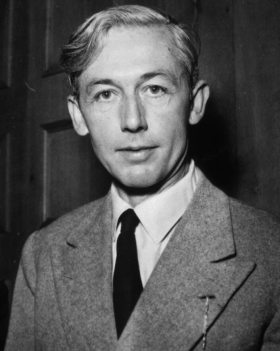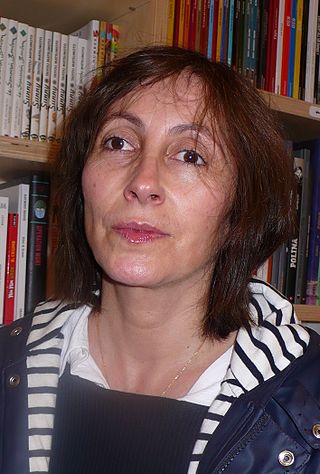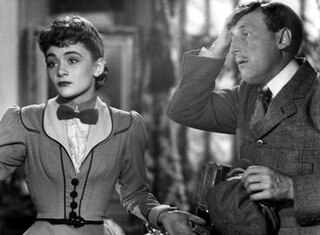
Robert Bresson was a French film director. Known for his ascetic approach, Bresson made a notable contribution to the art of cinema; his non-professional actors, ellipses, and sparse use of scoring have led his works to be regarded as preeminent examples of minimalist film. Much of his work is known for being tragic in story and nature.

Christmas Carole is a 2024 French Christmas comedy film directed by Jeanne Gottesdiener in her feature directorial debut. Gottesdiener co-wrote the script with Julie Ponsonnet based on the 2022 PAGE Award Bronze winning English-language screenplay Nutcrackers by American author Chrissy Lessey. The film stars Noémie Lvovsky and Didier Bourdon in the lead roles. After screening at various film festivals, it is scheduled for wide theatrical release on 14 November 2024 in Germany and on 18 December 2024 in France, Belgium and French-speaking Switzerland.
The Prix Jean Vigo is an award in the French cinema given annually since 1951 to a French film director, in homage to Jean Vigo. Since 1960, the award has been given to both a director of a feature film and to a director of a short film. The award is usually given to a young director, for their independent spirit and stylistic originality.

The Last Metro is a 1980 historical drama film, written and directed by François Truffaut, that stars Catherine Deneuve and Gérard Depardieu.
La Fémis is a French grande école and the film and television school of PSL Research University.

Olivier Py is a French stage director, actor and writer.

Kings and Queen is a 2004 French drama film directed by Arnaud Desplechin, starring Emmanuelle Devos and Mathieu Amalric. The film had its world premiere in the Competition section at the 61st Venice International Film Festival on 3 September 2004. It was released in France on 22 December 2004.
An auteur is an artist with a distinctive approach, usually a film director whose filmmaking control is so unbounded and personal that the director is likened to the "author" of the film, thus manifesting the director's unique style or thematic focus. As an unnamed value, auteurism originated in French film criticism of the late 1940s, and derives from the critical approach of André Bazin and Alexandre Astruc, whereas American critic Andrew Sarris in 1962 called it auteur theory. Yet the concept first appeared in French in 1955 when director François Truffaut termed it policy of the authors, and interpreted the films of some directors, like Alfred Hitchcock, as a body revealing recurring themes and preoccupations.
René Lefèvre was a French actor and writer. Throughout his career, he worked with several notable directors, like Jean Renoir, Jean-Pierre Melville, Jules Dassin, and René Clair.

Noémie Lvovsky is a French film director, screenwriter, and actress.

Lætitia Masson is a French film director and screenwriter. She has directed twelve films since 1991. Her film For Sale was screened in the Un Certain Regard section at the 1998 Cannes Film Festival.

The French Kissers is a 2009 French teen sex comedy film co-written and directed by Riad Sattouf, in his feature directorial debut. The film follows Hervé, an average teenage boy who has little luck with finding a girlfriend until the beautiful Aurore takes a liking to him.
Clubbed to Death (also known as Lola or Clubbed to Death (Lola)) is a 1996 French film starring Élodie Bouchez, directed by Yolande Zauberman, and co-written by Zauberman and Noémie Lvovsky. The film concerns a love triangle that forms between 20-year-old Lola (Bouchez) and the couple she encounters at an all-night rave.

Florence Seyvos is a French novelist, and screenwriter. Her films have been successful in French and in English.

Miquette is a 1950 French comedy film directed by Henri-Georges Clouzot and starring Louis Jouvet, Bourvil and Saturnin Fabre. The film was an adaptation of the play Miquette et sa mere by Robert de Flers and Gaston Arman de Caillavet, which had previously been adapted into 1934 and 1940 films. The film is set around the turn-of-the century.
Noémie is a female name of French origin. Uncommon variant spellings in French include Noémi and Noëmie. It is the French variation of the biblical Hebrew name Naomi, which can mean "good, pleasant, lovely, and wisdom."

Jacques Rivette was a French film director and film critic most commonly associated with the French New Wave and the film magazine Cahiers du Cinéma. He made twenty-nine films, including L'amour fou (1969), Out 1 (1971), Celine and Julie Go Boating (1974), and La Belle Noiseuse (1991). His work is noted for its improvisation, loose narratives, and lengthy running times.
Scarlet is a 2022 drama film, directed by Pietro Marcello, from a screenplay by Marcello, Maurizio Braucci, Maud Amelin, and Geneviève Brisac. It is loosely based on Scarlet Sails, a 1923 novel by Alexander Grin. It stars Raphaël Thiéry, Juliette Jouan, Louis Garrel, Noémie Lvovsky, Ernst Umhauer, François Négret and Yolande Moreau. It was a French-led production with co-production companies in Italy, Germany and Russia.
Nobody's Hero is a 2022 French comedy-drama film directed by Alain Guiraudie.

The Repentant is a 2002 French romantic thriller film written and directed by Laetitia Masson, and loosely based on the 1999 novella La Repentie by Didier Daeninckx. It stars Isabelle Adjani and marked her return to the screen after four years. With supporting roles by Sami Frey and Samy Naceri, Adjani portrays a woman who tries to escape her criminal past. It was released by ARP Sélection on 17 April 2002.











